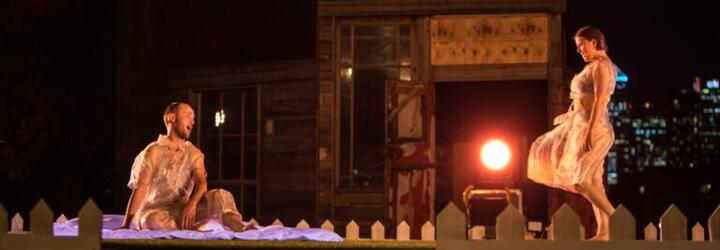
Paradise Lost is the Show from Hell for White Light
Adapted from John Milton’s epic poem, which charts the fall of Satan from heaven and Adam and Eve’s subsequent fall from Eden, Paradise Lost was recently adapted into a brand-new contemporary opera. Starring English National Opera’s Ella Taylor, it was performed outdoors at The Shipwright, in the garden of The Master Shipwright’s House in Deptford. The show featured a lighting design by Catja Hamilton who approached White Light to supply her rig.
The poem Paradise Lost is one of the most influential pieces of literature ever written; dealing with big themes such as heaven and hell, good and evil, sin, seduction, and deceit. As such, Catja felt this offered her the opportunity to make bold creative choices. She comments: “My brief was to find ways to make the lighting match the epic feeling of both the subject matter and the operatic form. Our director, Joseph Winters, was keen to use lighting to distinguish between the play’s locations: hell, the sun, Eden before the Fall, and Eden after the Fall. So, it was about playing with colour, intensity, and angle to create these really distinct feelings – a hell filled with fallen angels who’ve just been thrown out of Heaven, the sun, literal Paradise, and then a postlapsarian space where Adam and Eve realise the enormity of what they’ve lost.
She continues: “Milton’s poem is also full of imagery of light and darkness, which I drew on heavily for inspiration. Interestingly, hell is described as being completely void of light – the famous ‘darkness visible’ – so it took some thinking about how to evoke that while also ensuring the performers were visible to the audience”.

Knowing the exact feel she needed to achieve, Catja contacted WL and worked closely with the Hire department to draw on the exact fixtures required. These included 18 Chauvet ColourDash PARs as general cover and sidelight, 9 Chauvet Colorado Panel Q40 as footlights around the circular stage, one Elation SixPAR 200 as backlight, one Mac Quantum Wash as backlight and to represent the sun upstage, as well as several non-theatrical light sources including two rings of worklights around the circular stage – one lighting the stage and one pointing out towards the audience.
She explains: “The onstage worklights came on during the night-time scenes in Eden to suggest a more prison-like atmosphere than the assumed Paradise, and then with the Fall of Mankind to show the stripping away of that Paradisiacal illusion. At the Fall we also lost all the natural-toned colours and just kept in the worklights and Q40s in the same harsh white. I used the Mac Quantum Wash to represent the sun. As the light source was so visible it was almost like a set piece or practical and was really effective. The Q40s were then used to add colour, as backlight to sculpt, and to suggest the different colours of a sunrise and sunset throughout the piece.
She continues: “The angels and devils actually held their own torches which, at times, were used to light each other, particularly in the opening scene in hell. This was in part from a practical consideration – at the start, three of the performers were amongst the audience and due to the limited rig size, we didn’t have enough fixtures to light them there effectively. As such, we decided early on in the production process to rely on the torches for this scene. Having said that, it was actually really effective in evoking the darkness of hell to suggest that the devils needed the torches themselves to see”.

Given the show was taking place outdoors and in a non-conventional theatre space, this meant that there were some obstacles that Catja had to overcome. She states: “As we were performing outside, everything had to be IP rated, which, of course, limited the equipment we could use (the exception being the Mac Quantum Wash, which was inside a waterproof shack). This also meant there was little to no venue infrastructure for us to work with. Similarly, the venue has quite a limited power supply – a single 32A three-phase, one phase of which was used for sound and front of house. So, it was about designing a rig that could not only work outdoors but would also draw very little power, which further restricted the number of fixtures I could have”.
The show finished its run last month and was a contributor to the London Borough of Culture 2022.
Catja concludes: “I was incredibly proud of the work from myself and the entire team on Paradise Lost. I’d also like to say a big thanks to WL, in particular Stuart Porter and Sam Knight, who were incredibly helpful in helping me find available equipment that would achieve what I needed it to”.
Photos courtesy of Jack Sain.
The post Paradise Lost is the Show from Hell for White Light appeared first on White Light.






